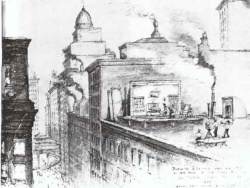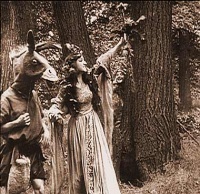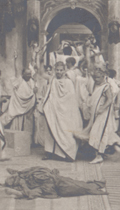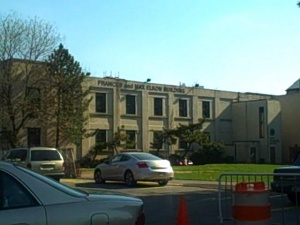From The Peopling of New York City
HOW SHULAMITH SCHOOL USED TO BE A SILENT MOVIE STUDIO
As we trek through the roads of time,
Let us enter the world of rhyme.
There is so much out there to explore,
Just follow me to find out more.
So “gentle reader,” take my hand,
for I can help your world expand.
Walk with me, and don’t get lost.
As through the annals of time we find ourselves tossed…
BEGINNINGS
In the borough of Brooklyn, between Avenues near "M,"
There is a small block, which houses a gem.
When near "Locust" and "Chestnut", keep your eyes open wide
To see the jewel of a building, with a school housed inside.
On East Fourteenth Street it stands nice and tall,
Let’s look up and notice that sign on the wall
Shulamith High School it says, but that’s not so true
For here we’ll find Elementary and Preschools, too!
But first there’s the tunnel, long and straight
These grounds tell of a history endowed by much fate.
This inconspicuous place shows history’s mark,
the embers of our past glow within this spark.
Let’s walk through this tunnel and see what we find…
Keep those empty guards’ posts in the front of your mind.
And as you start to enter the world filled with green
Begin to understand what your ancestors had seen.
Look to your right, Shulamith’s preschool you’ll see
But I wonder about that building and what it USED to be.
Before Shulamith brought it from Yeshiva University (YU),
It used to be a chem. lab. See, you’ve learnt something new!
But before that building held experiments galore,
It used to house costumes, props, scenery, and more!
The “factory” of the Vitagraph Company was there.[1]
“What’s the ‘Vitagraph Company’?” “The factory of where?”…
Yup, there’re many questions, much you don’t yet know
But the answers are all there, we’ll just have to take it slow…
INTRODUCTION
Welcome to Shulamith High School, a place where I was lucky enough to spend many years of my life. When Professor Wills introduced her amazing idea for our Wiki Project in Seminar Two, namely: find a street whose history you are curious to know more about, my mind jumped to my alma mater. I mean, isn’t it only natural for me to desire to learn more about the history of the building which has provided me with multiple opportunities to take my own journeys into the past?
Though I knew the previous life of Shulamith was filled with mystery, romance, and intrigue, I didn’t know nearly how many treasures I would be able to uncover after diving into her tumultuous depths until I jumped.
And now, I invite you to jump in with me, come on... the water's great.
First things first...
Let me tell you how to physically walk through the Shulamith School grounds.
Enter through the main gates (the ones that have YU HS embossed on them). If you did this properly, you’re in a tunnel. Walk through that tunnel, and you’ll end up on the gorgeous Shulamith campus. On either side of you now, is a big building. These two buildings are connected by a passageway (comprised, inside, of a gym and auditorium) located behind you. If you go into the building on your right, you’ll be in the preschool. If you enter the building on your left, you’ll end up bumping into elementary schoolers (on the first and second floors), middle schoolers (on the fourth floor), and high schoolers (on the third floor). In between the two structures is a grassy lawn-perfect for sun tanning or playing tag (our very own "quad," if you will). Beyond all the grass is a playground, usually occupied by many little preschoolers outside for their recess.
Here is a great arial view, in which we can notice the comparison between the Shulamith of today and the Vitagraph of yesteryear. (Rollover the picture to see who it's credited to)

Here We Go
This actual building was created in 1906, in the heart of a woodsy section in Brooklyn, the greatest borough in NYC. The site was picked because the buyers thought that the scenery would be just great for their purposes, and it was. J. Stuart Blackton and Albert E. Smith were about to open something that today, seems so commonplace, but back then was one of the first of its kind.
A movie studio. A real, live movie studio. In a patriotic attempt, the two British founders named their company American Vitagraph, and boy, did Vitagraph take off. As Anthony Slide records in his book,
The Big V, “By 1912, Albert E. Smith wrote, Vitagraph ‘had 400 people in our stock company and quite a small army of photographers, printers, developers and other workers in different branches of the business’(1987, page 2).”
But I get ahead of myself, let us go back to the beginning.
THE FOUNDERS OF THE VITAGRAPH COMPANY OF AMERICA
Prologue: Though the Vitagraph Company had a major role to play in various places around the globe, such as Paris and California, throughout this report, I aim only to feature your attention on the rich history revolving around this particular Brooklyn building, and its pertaining history. The vast majority of information in the following three sections was taken from The Big V by Anthony Slide. The Scarecrow Press Inc. Matuchen, N.J., and London. 1987.
J. Stuart Blackton was born on January 4, 1875, in Sheffield, England. He came to America as a child, where he started working, at the age of eleven or twelve, as the apprentice to a carpenter. During his spare time, however, he dreamt of working in show biz[4]...
Albert E. Smith was born on June 4, 1875 in the English county of Kent, to a large family. When Smith was 13, his family came to America. Smith, too became apprenticed to a carpenter, amongst various other apprenticeships. He then, however entered show business as a magician. As Anthony Slide writes in The Big V, "An early playbill describes [Smith] as 'The Prince of Entertainers, introducing original experiments in Prestidigitation, plus character impersonations, ventriloqual dialogues, and polyphonic imitations.'(1987, pg. 33-34)"
In 1894, these two men were introduced through a mutual friend named Ronald Reader, who had a feeling that his two friends, once put together, would be able to accomplish great things. Reader, Smith, and Blackton traveled together as "The International Novelty Company." They went around entertaining in fancy country-club-like places. They did magic, cartooning, and other fun things. After a while, though, their appeal kind of petered out, and they stopped doing their shows.
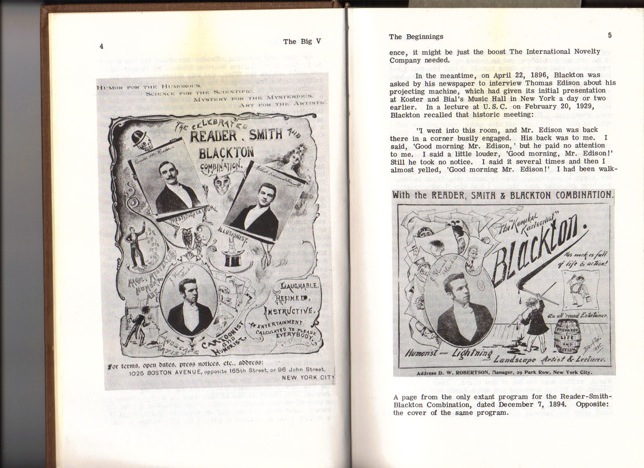 [5]
[5]
In April of 1896, Blackton, who was, at the time, working for The New York Evening World, was sent to interview Mr. Thomas Alva Edison about the marvelous new invention, the kinetoscope, that Edison had just invented. This machine was able to record and play back motion! During the interview, Edison noticed Blackton, aka "The Komical Kartoonist", carrying a sketch pad, and asked Blackton if he could sketch him. Edison liked the sketch so much, that he invited Blackton out to the "Black Maria," Edison's private 'movie studio.' Together, Edison and Blackton created "The Enchanted Drawing;" the movie you are about to see (posted on youtube by godshand). It is featured as being one of the (if not the) first examples of animated features in America.
The truth is, that much of what Blackton was doing was using "stop frame animation." This means they would stop the filming for a few seconds, change the frame, and begin filming again. This is not necessarily the same method used today, but it was an awesome starting point.
After doing this together, Blackton inquired about purchasing a kinetoscope machine, which he did in early 1897.
Smith and Blackton created a new partnership, and so began the famous Vitagraph Company.
So why did Blackton and Smith choose the name Vitagraph?
Anthony Slide records that the name was actually taken from Edison's "Vitascope." Blackton and Smith decided that Vita, which means "life", was a great name for their company. They added the word "graph" for its encompassing implications. As William Basil Courtney says, they "decided to adopt [Vitascope] with a more significant embellishment...Vitagraph, meaning life, picture, life portrayals. [6] At first, the newly developed motion picture technology just became another act in the Smith, Reader, and Blackton routine, to make it more interesting, and help them get back on their feet. But then, Smith and Blackton started getting involved in some motion picture advertising in late 1897. This led to film exhibition and and then to their interest in film production.
The first Vitagraph building was actually in Manhattan, and in that building, Blackton and Smith were able to film many short movies. But between 1898 and 1900, Edison began suing the partners, and it was agreed that Smith and Blackton would become Edison licensees. This meant that Edison would copyright all Vitagraph's films through 1900. But then, after a while, that contract dissolved because, had they kept the Edison-Vitagraph agreement, Edison would've closed them down. That's when the American Vitagraph Company became its own, independent corporation.
William “Pop” Rock was added to the Vitagraph team by 1900, the year of Vitagraph’s incorporation. He was named President while Smith became Treasurer, and Blackton, Secretary. Rock was loud-mouthed, boisterous, diamond wearing, always cursing, yet more mature than his youthful counterparts.
After “Pop” Rock’s inauguration to the company, it was decided that there should be a separation between the production aspect of Vitagraph’s motion pictures, and the business of selling them. Rock was given control of the sales division, and he set up shop in Vitagraph’s Nassau Street offices. However, Blackton and Smith needed a place to produce. In August 1905, the Vitagraph Company began building on East 15th street and Locust Avenue, in the Flatbush area of Brooklyn. The land was very close to the “Brighton Beach elevated railroad” (what is today the Avenue M line, running the Q and the B), and this point became very useful (I will discuss why a little later).
The Building and More (The Part You've Been Waiting For)
The Views and Film Index for August 25, 1906 described the building process in depth. “The new factory… will be ready for occupancy about September 15. The cost of the building is $25,000.” The concrete block building was “supplied with a 100 horse-power engine which will operate a dynamo, to furnish electric light, heat, and power for the machine shop and dark room.” There were also special stages, and apparatus designed to “[take] novel pictures with special scenic effects.” The new Vitagraph factory also included roofs made of heavy duty glass which would “[diffuse] and intensi[fy] the rays of light so that the shadows are not perceptible.(Slide, 1987, 12-14)"
Vitagraph was also able to start producing night scenes in their new studio, and the in the Views and Film Index for December 22, 1906, it says “The Vitagraph Co. of America has been experimenting largely with high candle power electric light, to be used in connection with the taking of motion pictures. Their experts have now perfected a marvellously brilliant lamp by means of which film exposure can be made at night as well as during the day… (Slide,14)”
With the introduction of this new and magnificent building, came the ability to divide filming. All indoors shots were still filmed in the Nassau Street building, and this new Flatbush property was used to shoot the outdoor scenes.
Whenever both indoor and outdoor shooting needed to be done, the actors of those scenes would take all the props and things they’d need over to the Flatbush studio, making use of the Brighton line. William Shea, in the August 1915 issue of Vitagraph Life Portrayals, remarked, “It must have been some sight to see fifteen or twenty people get off a train, some carrying bundles and boxes with a sword or a spear sticking out, a little bit of a fellow struggling along with a suit of armor, and various other bulky properties distributed among the members of the party, but it was all part of the game.[7]” After a while, though, the residents of the neighborhood got used to seeing the actors walking through the streets.
The first big picture taken in the Flatbush studios was Julius Caesar. In fact, according to The Folger Shakespeare Library, Vitagraph was actually one of the companies that pioneered the filming of Shakespeare plays.
[8]
Lest you think that bloopers are a modern day phenomenon, let me show you that the “pioneers” also encountered mistakes, albeit of a somewhat different nature. In the article mentioned above, William Shea anecdotally recalls how “During the taking of this picture a dog spoiled two hundred feet of film by walking into the scene during Anthony’s oration.”
Shea also lets us in on another secret. Shea reveals that, in those days, there were not even enough actors to go around. In fact, during the picture, "The Life of Washington", Shea played fifteen parts, “and in one scene—‘At Valley Forge’—I was compelled to die twice.(Slide, 14-15)”
Shea continued, saying that in those earlier days, if the actors of Vitagraph needed a special prop or piece of scenery, often they needed to make it themselves. “Frequently, when a picture was to be filmed, actors in costume came from all directions, with hammers, some with saws, others with paint brushes…In…”Romeo and Juliet,” the balcony scene was forgotten until the last minute, and the actor who was playing Romeo had to build his own balcony. (Slide, 15) ”
In 1908, Vitagraph opened a Paris office. By February 14, 1910, Vitagraph was releasing three reels of film a week, and the company’s profit in 1910 was over $600,000.
For a while all was picture perfect at the “Vitagraph Village.”
But then, on July 12, 1910, there was a big fire in the Nassau Street office, and the negatives of all the early Vitagraph productions were burnt to the ground. Vitagraph was, by this point “a leader in its field, entering a new decade, prosperous and powerful[,]” [9] and took the fire as a sign that its pioneering days were over [10]. The fire gave them the impetus to expand the Flatbush building, making it even more impressive, with various new offices in a new three-story structure. Throughout all this time Vitagraph was turning out picture after picture, with most of them turning into great successes. The amount of directors under contract was increasing steadily. The Vitagraph Company opened up a branch in Santa Monica, California in March of 1913, and that same year built a new glass-covered studio in Brooklyn. Vitagraph was thriving. In 1912, Louis Reeves Harrison wrote that “A visit to the Vitagraph plant leaves no doubt as to its resources…There are several studios in the main building and they can be operated by natural light alone or by artificial light alone or by the two in conjunction. This company was, in fact, the first to use electric light in taking moving pictures…[11]”
In Early 1914, Vitagraph made a mistake. They leased a theater in Manhattan and renamed it the Vitagraph Theater. In the beginning things were going great, but after a while, due in part, to the costly 75 cents they charged for people to see their plays, the theater proved more of a failure than a success.
Starting in the Spring of 1915, Vitagraph became a partner of three other organizations, and together the four companies were called the V-L-S-E (Vitagraph-Lubin-Selig-Essanay) Motion Picture Company. V-L-S-E became a very successful organization for Vitagraph, and they ended up buying out the other companies’ shares of stocks and interests.
A new Vitagraph branch was opened up in Long Island, in January of 1916. But then a few months later, on July 27, 1916, “Pop” Rock passed away, and with him the dreams of projects he had still hoped to make realities. This was one of the many events which led to the belief that 1916 was not a good year for the Vitagraph company. For throughout 1916, the financial situation of Vitagraph also took a bit of a plunge.
But throughout it all, Vitagraph managed to continue to follow a heavy business schedule, prompting Albert E. Smith to comment in 1919 that “The business is in A1 condition, being in better shape than at any time during the last two-and-a-half years.”[12]
In June of 1917, J. Stuart Blackton retired from Vitagraph to produce movies independently. But in the end, he failed at independent producing and rejoined the Vitagraph family in April 1923 where he was able to produce some of the best films of the twenties.
THE DOWNFALL OF VITAGRAPH
The truth is, that by the 1920s, Vitagraph was the oldest surviving film company in America, and the second oldest one in the world. Between 1921 and 1925, Vitagraph released 95 features, which is a lot, yet considerably less than some of the other studios around at the time.
In the twenties, after filing a law suit and withdrawing ties from the Motion Picture Producers and Distributors Association, Albert E. Smith realized that in order to stay in business, Vitagraph would need to become re-involved in exhibition and start a theater chain. Otherwise, the only thing left was to sell the company. Due to his failing health, Smith’s doctors made the decision for him, advising Smith to retire as soon as he could. In 1925, the entire estimated value of the Vitagraph Company was $4,200,000, but $43,000 had to be subtracted from that amount to repay a debt to the Guaranty Trust Company.[13]
Enter the Warner Bros. The brothers had been after Vitagraph for quite some time, and on April 20, 1925, Harry Warner signed the deal with Albert E. Smith in New York, and bought the Vitagraph Company for $735,000, [14] which was to be split between Smith, Blackton, and “Pop” Rock’s son, John. On April 22, Smith cabled the news to his staff, including his wishes that everything remain as before, and his hope that the actors would treat the Warners as they had treated Smith and Blackton. On April 27, J. Stuart Blackton resigned as Vice President of Vitagraph. And that was it; it was all over. Twenty nine years of action, and with one pen stroke, Vitagraph breathed its last.
It was a sad and sentimental time for many, and as George Smith wrote to his brother, “Seventh May and still raining. Guess the skies are weeping at the passing of the Olde Pioneers of Vitagraph. (Slide, 1987, page 123)”
THE DREAM CONTINUED
Yet the dream continues. The Warner Bros. called the former “Vitagraph Village” the Ace Film Laboratory. In that laboratory, the Warners were able to introduce ‘talkies’(!!!!!!) (That story's for another time).
It’s really incredible how so much of the cinema’s past can be found in the history of one small school in the middle of a hustling bustling city. I’m happy I picked this block’s secrets to uncover, because I think I’ve unearthed something that goes way beyond myself. The dreams of Vitagraph’s founders have come true, and today we have the power to do so much more than they’d ever imagined possible. The ironic thing is that they’re the ones who aren't here to see it.
Besides from that, who would've guessed this could all happen in Brooklyn? The pioneering of animation, indoor lighting with which to shoot motion pictures, and the first movies with speech-it's all pretty intense. But as Irvin Leigh Matus puts it: was it "[d]umb luck? Nah! Between you and me, pal, it could only have happened in Brooklyn.[15]"
VITAGRAPH STARS AND MORE
I want to read more
I want a review
I want to see some great movies
Take me to PAGE TWO.
REFERENCES
- ↑ http://nitrateville.com/viewtopic.php?t=2862&highlight=smokestack
- ↑ http://www.inkwellimagesink.com/pages/articles/CentennialOfAmericanAnimation.shtml
- ↑ http://www.findagrave.com
- ↑ Slide, Anthony. The Big V, The Scarecrow Press Inc. Matuchen, N.J., and London. 1987. Page 18-19
- ↑ Slide, Anthony. The Big V, The Scarecrow Press Inc., 1976.
- ↑ Slide, Anthony. The Big V, The Scarecrow Press, Inc. Metuchen, N.J. & London. 1987. Page 7
- ↑ Slide, Anthony. The Big V, The Scarecrow Press, Inc. Metuchen, N.J. & London. 1987. Pg 14-15
- ↑ http://www.shakespeareinamericanlife.org/stage/hollywood/silentfilms.cfm
- ↑ Slide, Anthony. The Big V, The Scarecrow Press, Inc. Metuchen, N.J. & London. 1987. Page 59
- ↑ ibid.
- ↑ Slide, Anthony. The Big V, The Scarecrow Press, Inc. Metuchen, N.J. & London. 1987. Page 63. The last line was emphasized by the author of this report.
- ↑ Slide, Anthony. The Big V, The Scarecrow Press, Inc. Metuchen, N.J. & London. 1987. Page 70
- ↑ Slide, Anthony. The Big V, The Scarecrow Press, Inc. Metuchen, N.J. & London. 1987. Page 121
- ↑ ibid. page 122
- ↑ http://urbanography.com/urban/0006/vita9.htm
ASKLAR
click me!!!
